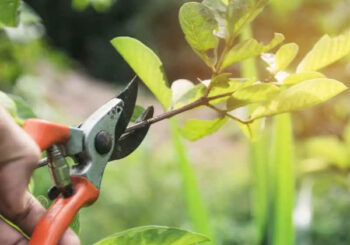By Amelia Harris
Staff Writer for Wake Up World
Welcome to the world of sustainable gardening! If you’re passionate about nurturing your garden while minimizing waste and maximizing its natural potential, then the “chop and drop” technique is your key to success.
This innovative method, widely embraced in permaculture and natural gardening, allows you to transform plant waste into a valuable resource that enriches your soil, suppresses weeds, and promotes a flourishing ecosystem. In this comprehensive guide, we’ll explore the benefits of chop and drop, how to implement it effectively, additional considerations, and its incredible impact on your garden’s health and vitality.
Understanding the Power of Chop and Drop
The Essence of Chop and Drop: Chop and drop is an essential practice that mimics natural processes, tapping into the cycle of life and death within your garden. By pruning or cutting plant materials and leaving them on the ground, you harness the power of decomposition, enriching your soil and creating a sustainable gardening system.
The Benefits of Chop and Drop:
Organic Matter Enrichment
Chop and drop provides a continuous supply of organic matter that breaks down slowly over time, releasing nutrients into the soil. This improves soil fertility, promotes healthy microbial activity, and enhances overall plant growth and productivity.
Moisture Retention
The layer of plant material acts as a natural mulch, reducing water evaporation from the soil surface. This conserves moisture, improves water penetration, and reduces the frequency of watering, ultimately conserving this precious resource.
Weed Suppression
Chop and drop creates a natural weed barrier by covering bare soil areas, preventing sunlight from reaching weed seeds and inhibiting their germination. This reduces the need for synthetic herbicides and promotes a healthier, weed-free garden.
Soil Protection
The layer of plant material serves as a protective shield for the soil. It prevents soil erosion caused by wind and heavy rainfall, reducing nutrient runoff and maintaining soil structure. Additionally, it acts as insulation, regulating soil temperature and protecting delicate roots from extreme weather conditions.
Enhancing Soil Ecology
Chop and drop fosters a thriving soil ecosystem. As the plant material decomposes, it attracts beneficial soil organisms, including earthworms, beetles, and microorganisms. These organisms improve soil structure, enhance nutrient cycling, and promote a balanced soil food web.
Implementing Chop and Drop Effectively
Assessing Plant Selection
When designing your garden, consider plants that naturally shed leaves, have prunable branches, or can be harvested regularly. These plants will provide an abundant supply of chop and drop materials, ensuring a steady flow of organic matter throughout the growing season.
Timing and Techniques
To maximize the effectiveness of chop and drop, follow these key techniques:
- Pruning Strategies: Focus on selective pruning, removing dead, diseased, or damaged branches to maintain plant health and shape. Avoid heavy pruning that may stress the plant excessively.
- Proper Cutting Techniques: Use clean, sharp tools to make clean cuts just above leaf nodes or bud unions. This minimizes damage to the plant and encourages faster decomposition.
- Layering Effect: Layer a variety of plant materials, such as leaves, small branches, and whole plants, to create a diverse mixture that decomposes at different rates. This ensures a balanced decomposition process and encourages a range of soil organisms to thrive.
Managing Chop and Drop in Your Garden: Consider the following:
- Placement Considerations: Distribute the plant materials evenly across your garden, ensuring they cover bare soil areas and focus around plants that require extra nutrient support. Avoid piling materials directly against plant stems to prevent rot or disease.
- Balancing Thickness: Aim for a layer of plant material that is approximately 3-4 inches thick. This allows for proper decomposition while preventing matting and suffocating the soil.
Maximizing the Potential of Chop and Drop
Observing the Decomposition Process: Chop and drop materials will gradually break down, incorporating into the soil. Be patient, as decomposition timelines vary based on factors such as plant type, weather conditions, and soil microbiology. Regularly monitor the progress, ensuring the materials are breaking down and integrating into the soil.
Additional Considerations:
- Planting Strategies: Incorporate chop and drop practices into your garden design. Consider the placement of plants to facilitate easy access for pruning and dropping materials. Group plants with similar pruning needs together for efficient maintenance.
- Composting Versatility: Chop and drop materials can also be utilized as valuable additions to your compost pile. By combining them with other organic matter, you can accelerate the decomposition process and create nutrient-rich compost for your garden.
Conclusion
Congratulations on embarking on the chop and drop journey, a sustainable gardening technique that empowers you to cultivate a vibrant, thriving garden while contributing to a healthier planet. By harnessing the power of decomposition and recycling plant waste, you’ll create a harmonious ecosystem that sustains itself for years to come. Embrace this practice, experiment with different plant materials, and observe the transformative impact it has on your garden’s health and vitality. Happy gardening!
About the author:
Amelia Harris is a writer and eco-activist, interested in health and all things esoteric, with a passion for sharing good news and inspiring stories. She is a staff writer for Wake Up World.

If you've found value in our articles, we invite you to support the release of our brand-new book, "Gratitude Practices for Kids: A Practical Guide for Adults to Instill a Spirit of Appreciation and Positivity in the Next Generation."
"Gratitude Practices for Kids" brings together over 25 innovative and accessible practices designed to enhance gratitude in everyday life. This comprehensive guide is backed by 17 scientific studies, ensuring each concept is grounded in research, underscoring our commitment to nurturing growth, emotional intelligence, and positive interactions between adults and children.
We encourage you to opt for the paperback version to celebrate this new release. Dive into its fresh pages away from digital distractions, allowing you to immerse yourself in the transformative practices it offers.
Over recent years, Wake Up World has faced significant online censorship, which has impacted our financial ability to operate. Moving into book publishing represents a strategic step to secure the ongoing funds needed to continue our mission. By purchasing Gratitude for Kids, you help us keep our content free and accessible to everyone, avoiding needing a paywall. With over 8,500 articles published in the last 13 years, we remain dedicated to keeping our valuable content open to all.









